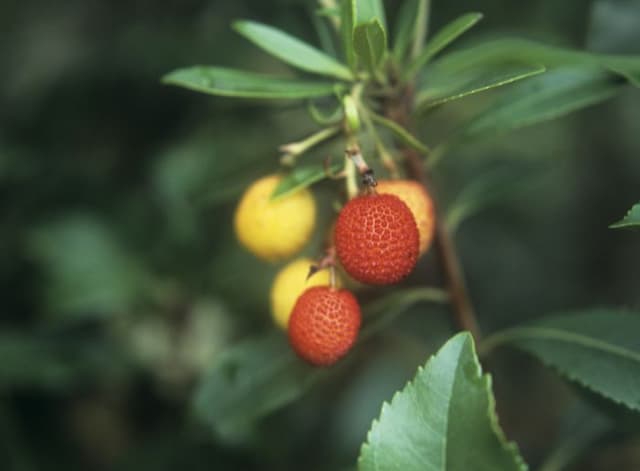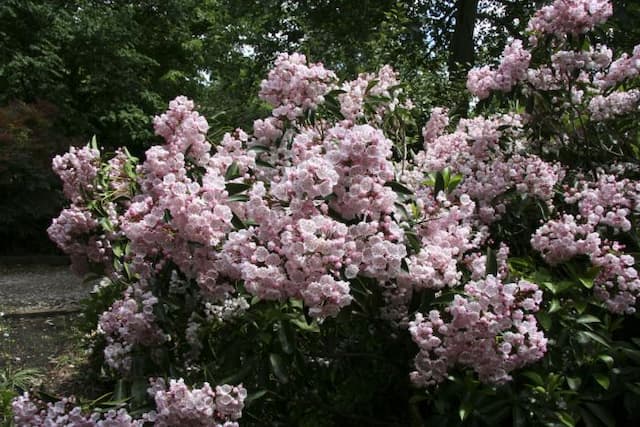Kamchatka rhododendron Rhododendron camtschaticum

ABOUT
The Kamchatka rhododendron is a low-growing, perennial shrub known for its stunning flowers and adaptability to cold environments. The foliage of this plant is notably small and oval, with a glossy, dark green appearance that sometimes takes on a reddish hue in colder temperatures. Its leaves are arranged in a dense, compact manner that adds to its overall lush appearance. The hallmark of this shrub is its blossoms, which emerge in clusters and can range in color from deep purple to pink, with some variations displaying a mix of both hues or even white. Each flower consists of a bell or funnel shape, with five distinct lobes that flare outward, creating an attractive, open shape that's very appealing to pollinators. The blossoms typically bloom in late spring to early summer, creating a vivid display that contrasts beautifully with the dark leaves. After the flowering season, the plant produces capsules that contain the seeds for the next generation. Through the change of seasons, the Kamchatka rhododendron continues to maintain its charm, with its evergreen leaves providing a constant hint of color in otherwise barren winter landscapes. This resilience and the plant's enchanting blooms make it a prized addition to rock gardens, borders, and as a ground cover in many a gardener's collection.
About this plant
 Names
NamesFamily
Ericaceae
Synonyms
Kamchatka Rhododendron, Kamchatka Azalea, Arctic Rhododendron, Kamchatka Rosebay
Common names
Rhododendron camtschaticum Pall., Rhododendron redowskianum Maxim., Therorhodion camtschaticum (Pall.) Small, Azalea camtschatica (Pall.) Kuntze, Rhododendron alpinum Pall.
 Toxicity
ToxicityTo humans
Kamchatka rhododendron contains grayanotoxins, which can be toxic to humans if ingested. Eating any part of the plant can cause symptoms such as vomiting, diarrhea, hypersalivation, weakness, and cardiac symptoms. Severe poisoning can lead to lethargy, hypotension, and potentially life-threatening cardiac complications.
To pets
Kamchatka rhododendron is toxic to pets due to grayanotoxins present in the plant. If pets consume any part of this rhododendron, they can experience symptoms such as vomiting, diarrhea, drooling, weakness, and central nervous system depression. In severe cases, ingestion can lead to coma, cardiovascular collapse, and potentially death.
 Characteristics
CharacteristicsLife cycle
Perennials
Foliage type
Deciduous
Color of leaves
Green
Flower color
Pink
Height
1 foot (30 cm)
Spread
1.5 feet (45 cm)
Plant type
Shrub
Hardiness zones
5
Native area
Siberia
Benefits
 General Benefits
General Benefits- Landscape Aesthetics: Rhododendron camtschaticum, commonly known as Kamchatka rhododendron, adds vibrant color and aesthetic appeal to gardens with its beautiful pink to purple flowers.
- Pollinator Attraction: The Kamchatka rhododendron's flowers are attractive to pollinators such as bees and butterflies, which play a crucial role in the ecosystem by aiding in plant fertilization.
- Erosion Control: This plant can help stabilize soil and prevent erosion due to its low-growing, spreading habit.
- Habitat Creation: Provides shelter and breeding grounds for various insects and small animals within its dense foliage.
- Low Maintenance: Kamchatka rhododendron typically requires minimal upkeep once established, making it suitable for low-maintenance gardening.
- Cultural Significance: In some cultures, the Kamchatka rhododendron is valued for its unique appearance and has been used in traditional ornamental gardens.
- Hardy Nature: It is very resilient and can survive in tough climates with cold temperatures, which makes it useful for landscaping in challenging environments.
 Medical Properties
Medical Properties- Anti-inflammatory: Rhododendron camtschaticum may contain compounds with anti-inflammatory effects.
- Analgesic: Some sources suggest potential pain-relieving properties.
- Antimicrobial: There may be antimicrobial substances in this plant that help inhibit the growth of certain bacteria or fungi.
- Antioxidant: The plant could have antioxidant components that help protect cells from damage caused by free radicals.
 Air-purifying Qualities
Air-purifying QualitiesThis plant is not specifically known for air purifying qualities.
 Other Uses
Other Uses- Edible Nectar: The nectar of Rhododendron camtschaticum (Kamchatka rhododendron) can be consumed directly by humans as a sweet treat or used as a natural sweetener in various dishes.
- Dye Source: Kamchatka rhododendron flowers and leaves have been used traditionally to produce natural dyes for coloring fabrics and other materials.
- Horticultural Specimen: This plant is cultivated for its ornamental value, appreciated in gardens and landscapes for its beautiful flowers and compact growth habit.
- Photography Subject: With its striking blossoms, Kamchatka rhododendron is a popular subject for nature photographers, contributing to botanical education and aesthetic appreciation.
- Cultural Symbol: In some cultures, the Kamchatka rhododendron is a symbol of spring and renewal and is used in various festivals and celebrations to signify these concepts.
- Botanical Studies: Due to its unique adaptation to cold environments, Kamchatka rhododendron is studied by botanists and ecologists interested in plant survival and adaptation mechanisms.
- Anchor Plant in Landscaping: Its ability to thrive in alpine and subalpine conditions makes it a useful anchor plant in landscape design for difficult climates.
- Biodiversity Support: Kamchatka rhododendron serves as a habitat and food source for various insects and bird species, playing a role in maintaining local biodiversity.
- Soil Erosion Control: The plant's root system can help stabilize soil and prevent erosion on slopes, making it useful in ecological restoration projects.
- Education and Interpretation: Kamchatka rhododendron provides an opportunity for educational interpretation in botanical gardens and parks, where visitors can learn about its characteristics and ecosystem role.
Interesting Facts
 Feng Shui
Feng ShuiThe Kamchatka rhododendron is not used in Feng Shui practice.
 Zodiac Sign Compitability
Zodiac Sign CompitabilityThe Kamchatka rhododendron is not used in astrology practice.
 Plant Symbolism
Plant Symbolism- Beware: Rhododendrons, in general, can contain toxic substances, thus they sometimes symbolize a warning to be cautious or to pay attention to potential danger.
- Elegance: The Rhododendron, often known for its beautiful, showy flowers, can represent elegance and wealth.
- Rejuvenation: As a plant that blooms vibrantly in spring, the Rhododendron can symbolize the idea of rebirth or starting anew.
- Homecoming: In certain cultures, the Rhododendron is seen as a symbol for coming home or returning safely, as they often grow in areas associated with comfort and familiarity.
 Water
WaterKamchatka rhododendron requires consistent moisture but should never be allowed to sit in waterlogged soil. It prefers well-draining soil, so water thoroughly whenever the top inch of soil feels dry to the touch. Typically, this might mean watering with about 1 gallon of water every week during growing season, but this can vary based on climate and weather conditions. During the winter, reduce watering but never allow the soil to completely dry out. Always check the soil moisture level before watering to avoid overwatering.
 Light
LightKamchatka rhododendron thrives in partial shade to full sun conditions. However, it prefers a spot that is sheltered from the harsh afternoon sun, especially in hotter climates. The ideal location provides morning sunlight with dappled or partial shade in the afternoon to protect its delicate leaves.
 Temperature
TemperatureKamchatka rhododendron is cold hardy and can tolerate a wide range of temperatures but grows best in areas where the average annual minimum temperature stays above -20 degrees Fahrenheit. It can survive in temperatures as low as -40 degrees Fahrenheit but the ideal growing temperatures are between 50 and 75 degrees Fahrenheit.
 Pruning
PruningKamchatka rhododendron should be pruned to maintain shape and encourage bushier growth. The best time to prune is immediately after blooming has finished, as the plant sets next year's flower buds soon after. Remove any dead or diseased branches, and trim back any overgrowth or leggy stems at this time. Pruning more than once a year is not typically necessary.
 Cleaning
CleaningAs needed
 Soil
SoilKamchatka rhododendron requires acidic soil with a pH range of 4.5 to 5.5. A recommended soil mix is a combination of peat moss, pine bark, and perlite in equal parts, which ensures good drainage and aeration. To maintain acidity, periodically amend the soil with sulfur or use acid-forming fertilizers.
 Repotting
RepottingThe Kamchatka rhododendron should be repotted every 2 to 3 years to refresh the soil and provide room for root growth. Repotting is best done in late winter or early spring before new growth begins.
 Humidity & Misting
Humidity & MistingThe Kamchatka rhododendron thrives in high humidity levels, ideally around 60-80%. If grown indoors, it may benefit from regular misting or the use of a humidifier to maintain optimal humidity.
 Suitable locations
Suitable locationsIndoor
Provide bright, indirect light and ensure high humidity.
Outdoor
Plant in partial shade with well-draining acidic soil.
Hardiness zone
4-9 USDA
 Life cycle
Life cycleRhododendron camtschaticum, commonly known as Kamchatka rhododendron, begins its life when its seeds germinate in well-drained, acidic soil, typically in spring or early summer. As a perennial shrub, it enters a juvenile phase where it develops a root system and foliage but does not yet flower. This vegetative stage lasts a few years, after which it matures and reaches the reproductive stage, producing distinctive pink to purple flowers which are often pollinated by insects. Following pollination, the plant develops seed capsules, which then mature and release seeds to complete the life cycle. Throughout its life, the Kamchatka rhododendron goes through annual cycles of growth in the spring and summer, followed by a period of dormancy during the cold winter months. The plant continues to grow and reproduce for many years, slowly expanding in size with each season.
 Propogation
PropogationPropogation time
Spring-Early Summer
The Kamchatka rhododendron, or Rhododendron camtschaticum, is commonly propagated by cuttings, which is the preferred method among home gardeners and professionals alike. This involves taking semi-ripe cuttings of the plant during the summer months, typically from new growth that is just beginning to harden. The cuttings, usually about 4-6 inches (roughly 10-15 centimeters) long, are taken with a clean, sharp cut just below a leaf node. Leaves on the lower half of the cutting should be removed, and the base can be treated with a rooting hormone to encourage root development. The prepared cuttings are then inserted into a well-draining rooting medium, such as a mix of peat and coarse sand, and kept in a humid environment with indirect light. Roots usually develop within a few weeks, after which the cuttings can gradually be acclimatized to less controlled conditions before being transplanted outdoors.









